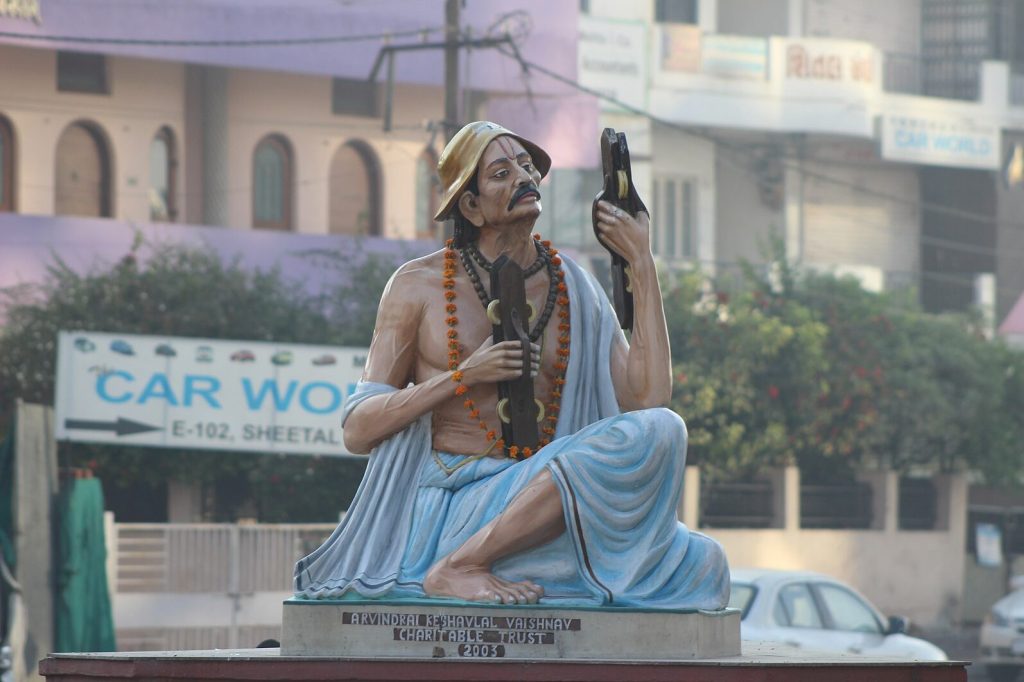Saint Narsinh Mehta also known as Narsi Bhagat, was a 15th-century saint and poet from Gujarat, India. He is widely revered for his spiritual teachings, devotion to Lord Krishna and his significant contributions to Gujarati literature. Narsi Mehta’s life and works continue to inspire millions of devotees to this day. In this blog, let’s delve into the life of this great saint along with learning about his works and contributions.

Fun Fact – In his honour, a new species of Spider was named “Narsinhmehtai”
Who was Narsinh Mehta?
- Narsi Mehta was born in the tiny village of Talaja in Saurashtra, Gujarat, in 1410.
- His father died when he was at the age of 5.
- It is believed he was born a dumb person but started talking after an old man asked him to chant Lord Krishna’s name at the age of 8 years.
- From an early age, he showed an inclination towards spirituality and displayed a deep devotion to Lord Krishna.
- He was raised by his brother Bansidhar and later was married to Manekbai.
- But he abstained from his duties and was always engaged in the devotion of the lord.
- He is believed to have eloped from home and did tapashyacharya for seven days at a Shiva Temple.
Also Read – Saint Nimbarka: Life, Philosophy and Work
Works and Contributions
Narsi Mehta was a prominent figure in the Bhakti movement, which emphasized personal devotion and love for the divine. The works of Mehta are profoundly remembered even today. Let’s know about some of them –
- Religious Teachings and Bhakti Movement
- He composed numerous hymns and devotional songs known as “bhajans” in the local language of Gujarati, making them accessible to the masses who were unable to understand Sanskrit.
- His bhajans celebrated the divine love between Lord Krishna and his devotee Radha, capturing the essence of devotion and spirituality and contributing to the Bhakti Movement.
.2. Poetry and Literature
- Narsi Mehta’s poetic genius is evident in his popular works such as “Vaishnav Jan To” and “Sudama Charitra,” which continue to resonate with people today.
- He wrote nearly 750 poems, which are famously called Padds in Gujrat.
- These padds mainly dealt with the devotion of Lord Krishna, Vairagya (Detachment from materialistic and worldly events) and Wisdom (Gyan).
- There are some autobiographical accounts from his life as different events took place like Hundi, Shalmshano, Harmala and Kunvarbainu Mameru.
Fun Fact – Vaishnav Jan To Tene Kahiye was penned by Narsinh Mehta.
It was the favourite bhajan of Mahatma Gandhi
Social Reforms and Philanthropy
- Narsi Mehta firmly believed in the upliftment of society and actively participated in social reforms during his time.
- He was declared an outcast as he mingled with Harijavanas and Dalits.
- He advocated for equal rights and dignity for all individuals, irrespective of caste or social status.
Cultural Influence and Legacy
- Narsi Mehta’s influence on Gujarati literature and culture is immeasurable.
- His bhajans are an integral part of Gujarat’s folk music heritage and are sung with great enthusiasm during religious festivals and gatherings.
Also Read – Saint Surdas: Life, Works, Quotes and Contribution
Saint Narsi Mehta’s timeless teachings and literary contributions are imprinted in the history of India. His devotion to Lord Krishna, social reforms, and promotion of equality resonated with people from all walks of life. Narsi Mehta’s legacy reminds us of the power of love, devotion, and moral righteousness in leading a fulfilling and meaningful life.
Relevant Blogs
| Saint Ramanujacharya | Adi Shankaracharya |
| Chaitanya Mahaprabhu | Sufi Movement |
| Vedanta Philosophy | Goswami Tulsidas |
| Saint Kabir Das | Gautam Buddha |
That’s all about Narsinh Mehta! If you want to know more about topics like this, then visit our general knowledge page! Alternatively, you can also read our blog on general knowledge for competitive exams!
 One app for all your study abroad needs
One app for all your study abroad needs














